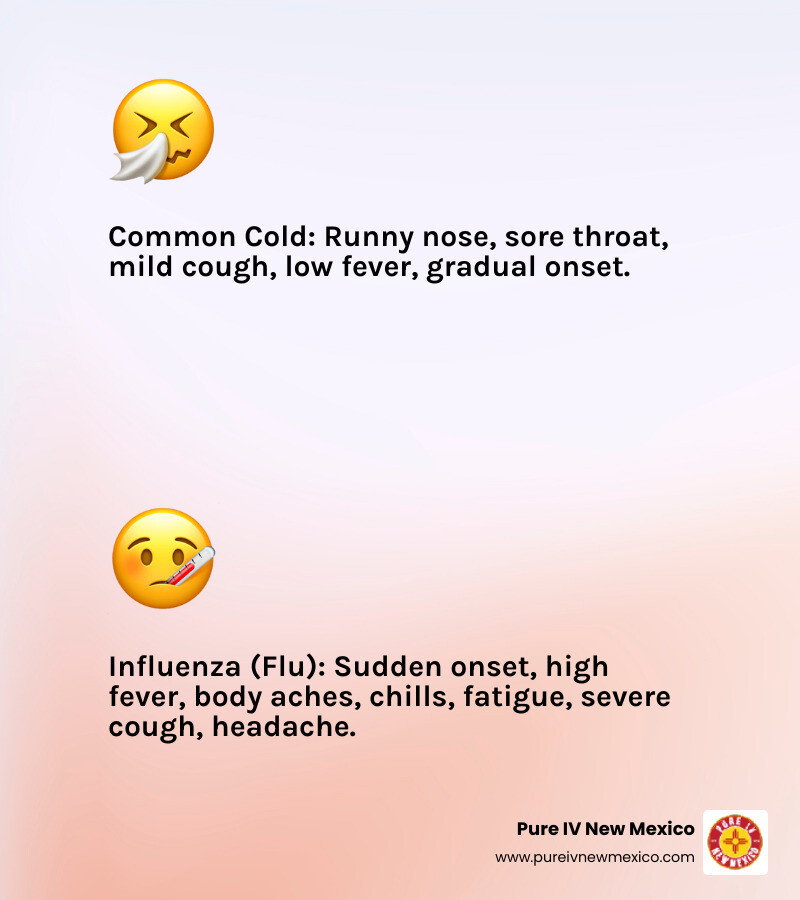Home Sweet Home Remedies for Quick Cold Relief

Medically reviewed by Micaela Strevay, FNP-C, PMHNP-BC
Table of Contents
Understanding the Common Cold
When you feel that familiar tickle in your throat or the first sniffles, getting cold relief at home is often the first thing on your mind. You want to feel better, fast.
Here's what you can do quickly for common cold symptoms:
- Rest: Get plenty of sleep. Your body needs it to fight off the virus.
- Hydrate: Drink lots of fluids like water, herbal tea, or broth. This helps thin mucus and prevents dehydration.
- Warm liquids: Sip on warm lemon water with honey or chicken soup to soothe a sore throat and ease congestion.
- Steam: Take a hot shower or use a humidifier to moisten airways.
- Saltwater gargle: Mix half a teaspoon of salt in 8 ounces of warm water and gargle to relieve throat pain.
The common cold, also known as an Upper Respiratory Infection (URI), is one of the most widespread illnesses worldwide. It's caused by viruses, mostly rhinoviruses, and it's highly contagious.
Typical symptoms include a runny nose, sore throat, cough, and sneezing. These usually stick around for about 5 to 10 days. But sometimes, a cough or runny nose can last for two weeks or more.
Knowing the difference between a cold and something more serious, like the flu, is important.
As co-founder of Pure IV New Mexico, I've spent years helping clients achieve optimal wellness, including providing effective solutions for cold relief at home through targeted hydration therapies. My experience focuses on bringing expert care and personalized treatments directly to you, ensuring quick recovery and symptom management.

Find more about cold relief at home :
Top Home Remedies for Soothing Cold Symptoms
When a cold hits, your body becomes a battlefield where viruses and your immune system duke it out. While there's no instant cure that'll have you feeling like a million bucks overnight, there are plenty of tried-and-true home remedies that can make you feel significantly better. These gentle, natural approaches offer real cold relief at home without breaking the bank or requiring a pharmacy run.

Soothing Sips: Hydration and Warm Liquids
Think of hydration as your body's best friend when you're fighting a cold. Your immune system is working overtime, and it needs all the support it can get. Staying well-hydrated is crucial for preventing dehydration , which can turn a manageable cold into a miserable experience with added headaches and fatigue.
But here's the real magic: proper hydration helps thin that stubborn mucus that's making you feel stuffed up. When mucus becomes thinner, it's much easier for your body to clear it from your nasal passages and chest. It's like turning thick honey into water – everything flows better.
Warm liquids deserve special mention because they're like a gentle hug for your irritated throat and congested airways. Warm water with lemon and honey is the classic go-to remedy, and there's solid science behind why it works. Honey brings natural antimicrobial properties to the table and can genuinely soothe both coughs and sore throats. The lemon adds a vitamin C boost while helping cut through mucus buildup. Just remember – honey should never be given to children under 1 year old due to safety concerns.
Herbal teas offer another comforting option. Ginger tea brings anti-inflammatory properties that may help ease symptoms, while chamomile and peppermint teas provide soothing warmth. The steam rising from your mug also helps relieve stuffiness – it's a two-for-one deal.
And yes, chicken soup really does help ! Scientific research backs up what grandmothers have known for generations – chicken soup can calm inflammation in your body and help loosen mucus, reducing congestion. Plus, it provides easily digestible fluids, electrolytes, and nutrients when your appetite might be lacking.
For times when you need rapid rehydration, especially if fever or other symptoms have left you depleted, professional hydration support can make a real difference. Check out the easy guide to hydration therapy at home to learn how targeted IV hydration can accelerate your recovery.
Breathe Easier: Steam and Moisture for Congestion
That stuffy, can't-breathe-through-your-nose feeling is one of the most frustrating parts of having a cold. The good news? Adding moisture to your environment can provide significant cold relief at home and help you breathe easier.
Steam inhalation works by delivering warm, moist air directly to your irritated nasal passages and throat. The easiest method is taking a hot, steamy shower – let that bathroom fill up with steam and breathe deeply. For a more targeted approach, you can lean over a bowl of hot (not boiling) water with a towel draped over your head to trap the steam. Just be careful not to get too close and burn yourself.
Humidifiers are game-changers , especially at night when congestion tends to worsen. A cool-mist humidifier in your bedroom adds moisture to dry air, soothing irritated tissues and making breathing more comfortable. Remember to clean your humidifier daily according to the manufacturer's instructions – nobody wants to add mold or bacteria to the mix.
Saline nasal sprays offer gentle relief by moistening nasal passages and washing away irritants. You can buy ready-made versions or create your own by mixing 1/4 to 1/2 teaspoon of salt in 8 ounces of distilled or previously boiled water.
For throat relief, try a saltwater gargle using 1/2 teaspoon of salt in 8 ounces of warm water . Gargle for about 30 seconds several times daily. The salt draws out excess fluid from swollen throat tissues, providing real relief. Research even suggests that regular gargling may help prevent upper respiratory infections.
Elevating your head during sleep can work wonders for nighttime congestion. Prop yourself up with extra pillows to create a gentle slope that allows sinus fluids to drain naturally instead of pooling and causing stuffiness.
Natural Boosters: Foods and Supplements for Cold Relief at Home
Your kitchen holds several natural allies in the fight against cold symptoms. While these aren't miracle cures, they can support your immune system and provide additional comfort during recovery.

Vitamin C might not prevent colds in most people, but some studies suggest it can shorten duration by about a day when taken before symptoms appear. Load up on vitamin C-rich foods like oranges, strawberries, bell peppers, and broccoli . These colorful options taste good and provide immune-supporting antioxidants.
Zinc lozenges show promise in some studies for shortening cold duration when taken within the first few days of symptoms. However, results are mixed, and it's important to avoid nasal zinc products, which can permanently damage your sense of smell.
Echinacea research shows mixed results, with some studies suggesting it may reduce cold length and severity by 10-30%. The inconsistent findings might be due to different plant varieties being tested, so consult a healthcare provider before trying it.
Don't overlook ginger's anti-inflammatory properties – whether in tea, fresh slices, or added to meals. Garlic brings immune-boosting compounds to your dishes, while probiotics found in yogurt, kefir, and fermented foods support gut health, which is closely linked to immune function.
These natural approaches work best when combined with plenty of rest and hydration, giving your body the support it needs to fight off the virus and get you back to feeling like yourself again.
General Wellness and Prevention Tips
While we're busy finding the best cold relief at home strategies, let's not forget the bigger picture! Supporting our overall well-being and preventing the spread of those pesky germs are just as important. These simple habits not only help you get better but also protect your loved ones and community.
First up, and arguably the most crucial tip for bouncing back, is prioritizing rest . When you're feeling under the weather, your body is working overtime to fight off that virus. Think of sleep as your immune system's secret weapon! While you're snoozing, your body busily makes special proteins called cytokines. These little helpers are vital for fighting off infections and calming inflammation. So, give your body the gift of rest – aim for a solid 8-10 hours of sleep each night when a cold strikes. It truly helps your immune system do its very best work.
When that stuffy nose hits, it's tempting to blow with all your might. But hold on a second! Try a gentle nose blowing technique instead. Press a finger over one nostril and gently clear the other. Blowing too hard can actually create pressure that pushes mucus (and those viruses!) into your ear passages. We certainly don't want to add an earache or infection to your cold symptoms, do we?
Now, let's talk about keeping those germs from spreading their chilly cheer. The common cold is super contagious, and it loves to travel! It spreads mainly through tiny virus-carrying droplets that fly into the air when someone coughs or sneezes. It can also live on surfaces, just waiting for a hand to touch them.
This is where hand washing becomes your superhero move. Wash your hands often with good old soap and water for at least 20 seconds . That's about the time it takes to sing "Happy Birthday" twice! Make sure to wash up especially after coughing, sneezing, or blowing your nose, and always before you eat. It's truly one of the most effective ways to stop cold germs in their tracks. If you can't get to a sink, an alcohol-based hand sanitizer with at least 60% alcohol is your next best friend.
And when you feel a cough or sneeze coming on? Be a germ-stopper! Always cough or sneeze into a tissue , then toss it right away. If a tissue isn't handy, aim for the crook of your elbow , not your hands. This simple act keeps those germs contained.
Finally, and this might be the hardest one, if you're sick, please stay home . We know you're important, but heading to work, school, or social gatherings when you have cold symptoms is like inviting everyone else to join your cold party. And trust us, no one wants an invitation to that! Staying home is a kind and responsible way to prevent further transmission and help everyone stay healthier.
What to Avoid for Effective Cold Relief at Home
When you're searching for cold relief at home , knowing what helps is key. But just as important is understanding what might actually make things worse, or simply waste your time and energy. Let's talk about some common pitfalls to steer clear of when you're battling a cold.
First up, a big one: antibiotics . It’s a common mix-up, but colds are caused by viruses, not bacteria. Think of it like this: antibiotics are like special keys that only open up bacterial problems. They simply don't work on viruses. Taking them when you have a cold won't help you feel better, and even worse, it contributes to something called antibiotic resistance. This means those powerful medicines might not work when you truly need them for a bacterial infection down the road. So, save the antibiotics for when your doctor confirms a bacterial issue.
Next, let's chat about those quick-fix decongestant nasal sprays . They can feel like a miracle when your nose is completely blocked, right? And they are fine for a day or two. But here's the catch: using them for more than three to five days can lead to a "rebound effect." This means your stuffiness can actually get worse when you stop using them, trapping you in a cycle of needing the spray. So, use them sparingly and stick to the recommended duration.
When you're feeling under the weather, it might be tempting to reach for a comforting cup of coffee or even a nightcap. But alcohol and caffeine are actually dehydrating. And as we've talked about, hydration is your best friend when fighting a cold! Alcohol can also inflame the delicate membranes in your nose and throat, potentially making your symptoms feel even worse. Best to stick to water, herbal teas, and broths.
This one might seem obvious, but it's crucial: smoking and secondhand smoke . Your respiratory system is already working overtime to fight off the cold virus. Adding irritating smoke to the mix just makes things harder. It can worsen your cough, make your throat sorer, and generally prolong your recovery. Give your lungs a break and avoid smoke completely.
We all love staying active, but when a cold hits, it's time to ease up. Strenuous exercise can put extra stress on your body when it should be focusing all its energy on healing. Some doctors use the 'neck rule': if your symptoms are only 'above the neck' (like a runny nose or sore throat), light activity might be okay. But if you have chest congestion, body aches, or a fever, rest is definitely best. Pushing yourself too hard can actually prolong your illness.
Finally, a very important note for parents: be extremely cautious with over-the-counter (OTC) cough and cold medicines for young children .
- For children under 4 years old , it's generally recommended to avoid OTC cough and cold medicines altogether. They can have serious side effects and often aren't very effective for this age group.
- If your child is between 4 and 6 years old , always talk to your healthcare provider before giving them any OTC cold medicine.
- Remember our earlier tip about honey? Honey should never be given to children under 1 year old due to a risk of infant botulism.
- Also, Vicks VapoRub isn't suitable for children under 2 years .
- And a long-standing warning: never give aspirin to children or teenagers because of the risk of Reye's syndrome, a rare but very serious condition.
- Always, always read medicine labels carefully for proper dosage and age restrictions before giving anything to your child.
When to Swap Home Care for a Doctor's Visit
While most common colds are truly a case for cold relief at home and will clear up on their own, there are times when your body sends a stronger signal. It’s super important to know these signs so you can get the right help when you need it. After all, your well-being is our top priority at Pure IV New Mexico, and that includes knowing when it's time to call in the professionals.

So, how do you know if your cold has overstayed its welcome or is turning into something more serious? Keep an eye out for these key indicators.
It's a good idea to reach out to a doctor if you notice a high or persistent fever – that’s generally anything above 38.9°C (102°F), or if a lower fever sticks around for more than three days. Also, pay close attention if your symptoms are worsening or not improving at all after about 10 days. For those in high-risk groups, like the very young, elderly, or those with underlying health conditions, it's wise to seek attention if symptoms last for 5 days. You know your body best, and if things just don’t feel right, trust that instinct.
Beyond the general timeline, certain severe symptoms should never be ignored. If you experience difficulty breathing or shortness of breath , that’s a clear sign to get immediate medical attention. Similarly, sudden or severe chest pain or abdominal pain can indicate more serious underlying issues. Watch out for sudden changes in mental state, such as dizziness or confusion . If you’re dealing with severe vomiting that doesn't go away , it can lead to dangerous dehydration. Don't push through a severe sore throat or swollen tonsils , especially if it makes swallowing or breathing difficult. Intense headaches or sinus pressure that don't ease up with typical pain relievers are also worth a check. And if you have ear pain and discharge , it could point to an ear infection that needs treatment.
It’s also worth a doctor’s visit if you feel like you’re getting recurring colds , where you just can't seem to shake one before another starts. And if you have existing respiratory or heart conditions like asthma or heart disease, any cold symptoms impacting your pre-existing health need careful monitoring and a chat with your healthcare provider. Your body is working extra hard, and sometimes it needs a little professional backup.
Knowing when to seek medical attention for a cold can truly make a difference in your recovery and prevent potential complications.
Frequently Asked Questions about At-Home Cold Relief
When that familiar sniffle starts, it's natural to have questions about how to feel better and what to expect. Let's tackle some common queries about managing your cold relief at home with clear, friendly answers.
How long does a common cold typically last?
Ah, the million-dollar question! While we all wish colds would vanish as quickly as they appear, they usually have their own timeline. For most adults, a common cold typically lasts about 5 to 10 days . However, don't be surprised if some symptoms, like a lingering cough or a runny nose, decide to stick around a bit longer – sometimes for 14 days or even more . It really depends on your individual health and how your body's amazing immune system responds. Did you know that adults can catch a cold 2 to 4 times a year on average, while little ones might get them even more often, around 3 to 8 times a year? It's quite common!
Can you "sweat out" a cold with exercise?
This is a common myth we hear, and while the idea of "sweating it out" might sound appealing, the answer is generally no . When you're battling a cold, your body is already working incredibly hard to fight off the virus. Pushing yourself through strenuous exercise can actually add more stress to your system. Think of it this way: your body needs all its energy to heal, and a tough workout can divert that energy, potentially prolonging your illness or even making your symptoms feel worse.
Instead of hitting the gym hard, rest is crucial for recovery. It allows your immune system to focus on its important work. If you're feeling up to it and your symptoms are "above the neck" (like a runny nose or sore throat, but no fever or body aches), a gentle walk might be okay. But if you feel fatigued, have a fever, or experience "below the neck" symptoms like chest congestion or body aches, it's definitely time to snuggle up and rest. Listen to your body – it knows best!
Are antibiotics effective for treating a cold?
This is a really important point to remember, and the answer is a clear no . Colds are caused by viruses , and antibiotics are specifically designed to treat bacterial infections . They simply don't work against viruses. Taking antibiotics when you have a cold won't help you feel better, and it can actually contribute to a bigger problem known as antibiotic resistance . This means that if you use antibiotics unnecessarily, they might not work as well when you truly need them for a bacterial infection in the future. So, for effective cold relief at home , stick to symptom management and let your body do its job fighting the virus!
Conclusion: Your Path to Feeling Better Faster
Feeling under the weather with a cold can truly knock the wind out of your sails. But as we've explored, you have so many powerful tools right at your fingertips for effective cold relief at home . It's all about giving your body the support it needs to fight back and get you back on your feet faster.
We've covered everything from the soothing magic of hydration and warm liquids like herbal teas and chicken soup , to the comforting power of steam for clearing congestion. Remember those natural boosters like Vitamin C-rich foods and the potential benefits of zinc and ginger ? These simple steps, combined with plenty of rest and smart symptom management , are your best friends when a cold strikes.
Perhaps most importantly, remember to listen to your body . While these home remedies are incredibly effective for most common colds, pay close attention to how you're feeling. If your symptoms worsen, don't improve after about 10 days, or if you experience concerning signs like high fever or difficulty breathing, don't hesitate to reach out to a healthcare professional. Your well-being is always the top priority.
For those moments when you feel truly drained and need an extra boost to help your body recover faster, Pure IV New Mexico is here for you. We understand that sometimes, your system needs a little more than just sips and rest. Our specialized IV treatments are designed to deliver essential fluids, vitamins, and minerals directly into your bloodstream, offering a rapid immune and hydration boost when you need it most. It's a convenient, personalized way to support your recovery, all delivered by licensed professionals.
Ready to learn more about how we can help you bounce back? Find the benefits of IV therapy for cold and flu relief and let us help you on your path to feeling better, faster.





